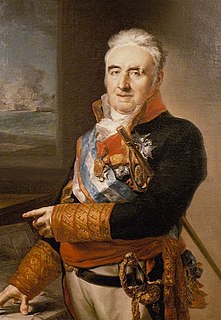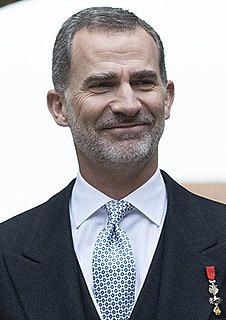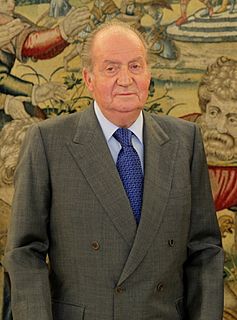 W
WIgnacio María de Álava y Sáenz de Navarrete was a Spanish naval officer, present at the Battle of Trafalgar.
 W
WAlfonso XII, also known as El Pacificador or the Peacemaker, was King of Spain from 29 December 1874 to his death in 1885. After a revolution that deposed his mother Isabella II from the throne in 1868, Alfonso studied in Austria and France. His mother abdicated in his favour in 1870, and he returned to Spain as king in 1874 following a military coup against the First Republic. Alfonso died aged 27 in 1885, and was succeeded by his son, Alfonso XIII, who was born the following year. He is the most recent monarch of Spain to have died while on the throne.
 W
WAlfonso XIII, also known as El Africano or the African, was King of Spain from 17 May 1886 to 14 April 1931, when the Spanish Second Republic was proclaimed. He was a monarch from birth as his father, Alfonso XII, had died the previous year. Alfonso's mother, Maria Christina of Austria, served as regent until he assumed full powers on his sixteenth birthday in 1902.
 W
WFadrique de Toledo or Fadrique Álvarez de Toledo y Mendoza, 1st Marquess of Valdueza, was a Spanish noble and admiral. He was a Knight of the Order of Santiago and Captain General of the Spanish Navy at the age of 37.
 W
WAmadeo I was an Italian prince who reigned as King of Spain from 1870 to 1873. The first and only King of Spain from the House of Savoy, he was the second son of King Vittorio Emanuele II of Italy and was known for most of his life as The Duke of Aosta.
 W
WFrancisco Armero Peñaranda, Marquess of Nervión and Grandee of Spain was a Spanish Captain general of the Navy and politician.
 W
WAdmiral Juan Bautista Aznar-Cabañas was the Prime Minister of Spain from the resignation of Dámaso Berenguer y Fusté on to the deposition of King Alfonso XIII and the proclamation of the Spanish Second Republic on April 14, 1931.
 W
WLuis Carrero Blanco was a Spanish Navy officer and politician, who served as Prime Minister from June 1973 until his assassination in December of that year. He participated in the Rif War, and later the Spanish Civil War, in which he supported the Nationalist faction.
 W
WAdmiral Luis de Córdova y Córdova was a Spanish admiral. He is best known for his command of the Spanish fleet during the Anglo-Spanish War. His best remembered actions were the capture of two merchant convoys totalling 79 ships between 1780 and 1782, including the capture of 55 ships from a convoy composed of Indiamen, and other cargo ships 60 leagues off Cape St. Vincent. In 1782 he battled the Royal Navy to a stalemate at the Battle of Cape Spartel, but failed to prevent the British relieving the Great Siege of Gibraltar.
 W
WFelipe VI or Philip VI is the King of Spain. He ascended the throne on 19 June 2014 upon the abdication of his father, Juan Carlos I. His mother is Queen Sofía, and he has two elder sisters, Infanta Elena, Duchess of Lugo, and Infanta Cristina. In 2004, Felipe married TV news journalist Letizia Ortiz with whom he has two daughters, Leonor and Sofía.
 W
WFrancisco Gil de Taboada y Lemos was a Spanish naval officer and colonial administrator in South America. He was briefly viceroy of New Granada in 1789, and from March 25, 1790 to June 6, 1796 he was viceroy of Peru. After his viceregal service he returned to Spain, where he became a member of the governing junta after King Ferdinand VII was forced to abdicate by Napoleon. He was director general of the Spanish Royal Navy.
 W
WFederico Carlos Gravina y Nápoli was a Spanish admiral during the American Revolution and Napoleonic Wars. He died of wounds sustained during the Battle of Trafalgar. Explorer Jacinto Caamaño named the Gravina Island in Alaska in his honor.
 W
WJuan Carlos I is a member of the Spanish royal family who reigned as King of Spain from 22 November 1975 until his abdication on 19 June 2014. In Spain, since his abdication, Juan Carlos has usually been referred to as the Rey Emérito.
 W
WInfante Juan of Spain, Count of Barcelona, also known as Don Juan, was the third son and designated heir of King Alfonso XIII of Spain and Victoria Eugenie of Battenberg. His father was replaced by the Second Spanish Republic, and under his son, Juan Carlos I, a constitutional monarchy was installed.
 W
WJuan Francisco de Lángara y Huarte was a Spanish naval officer and Minister of Marine.
 W
WThe military career of Francisco Franco Bahamonde began on 29 August 1907, when he took the oath as a cadet at the Spanish Toledo Infantry Academy. On 13 July 1910 he graduated from Infantry Academy and was commissioned as a second lieutenant in the Spanish Army, in the same promotion as Juan Yagüe, Emilio Esteban Infantes, Camilo Alonso Vega, José Asensio, Lisardo Doval Bravo and Eduardo Sáenz de Buruaga. He rose through the ranks over the next twenty years and became one of the most important Spanish commissioned officers of the Rif War. On 31 January 1926 Franco, aged 33, became the youngest general in all of Europe. In January 1928 he was then chosen to direct the newly formed General Military Academy in Zaragoza. From 19 May 1935 to 23 February 1936, Franco was elevated to Chief of Army Staff before the 1936 election moved the leftist Popular Front into power, relegating him to the Canary Islands as Commander of the Archipelago Force. After initial reluctance, he joined the July 1936 military coup which, after failing to take Spain, sparked the Spanish Civil War.
 W
WJuan José Navarro y Búfalo, 1st Marquess of Victoria, OSJ was a Spanish military officer and first Captain General of the Spanish Navy.
 W
WJuan José Ruiz de Apodaca y Eliza, 1st Count of Venadito, OIC, OSH, KOC was a Spanish naval officer and viceroy of New Spain from 20 September 1816 to 5 July 1821, during Mexico's War of Independence.
 W
WDon José de Solano y Bote Carrasco y Díaz, Marquess of Socorro, was a Spanish naval officer.
 W
WAntonio Valdés y Fernández Bazán was a naval officer of the Spanish Royal Navy.
 W
WCayetano Valdés y Flores Bazán (1767–1835) was a commander of the Spanish Navy, explorer, and captain general who served in the French Revolutionary and Napoleonic Wars, fighting for both sides at different times due to the changing fortunes of Spain in the conflict. He took part in a number of naval battles, including the Great Siege of Gibraltar, the Battle of Cape St Vincent, and the Battle of Trafalgar. He was an explorer, most notable in the Pacific Northwest, where he and Dionisio Alcalá Galiano conducted the first circumnavigation of Vancouver Island, in partial cooperation with George Vancouver. Over his long career he achieved the highest ranks in the Spanish Navy, eventually being named Captain General of Cadiz and Captain General of the Spanish Navy.